Did you know that 51% of employees feel like they can’t openly share their opinion at work?
These findings from the Belonging in the Workplace study by Opinium and ISS are quite problematic. Employee’s unaddressed concerns can escalate and lead to serious repercussions, such as increased stress at work, conflicts, a decrease in productivity, and even resignation.
Upward communication, i.e., the information flow from subordinates to their superiors, is essential for the overall health and success of any organization.
This is why, in this blog post, we’ll:
- Provide a more detailed definition of upward communication,
- Talk about its benefits for everyone involved,
- Consider some of its problems, and
- Offer actionable tips on how you can make upward communication more effective in your workplace.
Let’s start.

- Upward communication is a bottom-up communication flow from lower-level employees to their superiors.
- Some of the outcomes of poor or non-existent upward communication include having limited perspective and poor decision making, as well as increased stress and lower job satisfaction.
- Leaders are responsible for cultivating a workplace culture that encourages upward communication by creating an open and receptive environment for these discussions, while also serving as a strong role model through active listening and a proactive approach to upward feedback.
- Building a culture of open, upward communication requires the right tools that make it easier for employees to share their thoughts and ideas, ask questions, and offer suggestions.
Table of Contents
What is upward communication?
Upward communication is a communication type along the vertical axis of interaction in an organization. In other words, it’s a bottom-up communication flow from lower-level employees to their superiors.
Through this type of interaction, employees can voice their:
- Opinions,
- Concerns,
- Ideas,
- Suggestions,
- Complaints, and
- Comments about the day-to-day operations in the company.
Upward communication doesn’t necessarily involve employees communicating with their immediate supervisors — they can “skip a few rungs up the ladder” and report to higher management.
This practice is associated with internal whistleblowing, which employees resort to when they want to report the misconduct of their superiors to someone higher up the command chain.
To better understand upward communication, let’s contrast it with its counterpart — downward communication. Downward communication flows in the opposite direction — from superiors to subordinates. In a way, downward communication is the default mode of organizational communication, as it ensures everyone knows what their responsibilities are and what the common goal is.
💡 Pumble Pro Tip
Upward and downward communication types follow the vertical line of interaction in an organization. To explore other directions team communication can take, you can check out the following resources:
Examples of upward communication
Let’s get a closer look of how upward communication can look like in an organization by going through some examples of it and explaining its benefits.
- Manager feedback surveys — Great way to gauge the employee sentiment about the performance of their supervisor, thus encouraging constructive upward communication.
- Employee polls — Including the team in the decision-making process leads to much better decisions.
- Suggestion boxes — Anonymous suggestions create a direct channel for uninhibited upward communication.
- Unprompted employee feedback to management — Having an open-door policy makes employees feel free to directly approach you on any issue, be it in person or via another company communication channel, like in the following Pumble example:
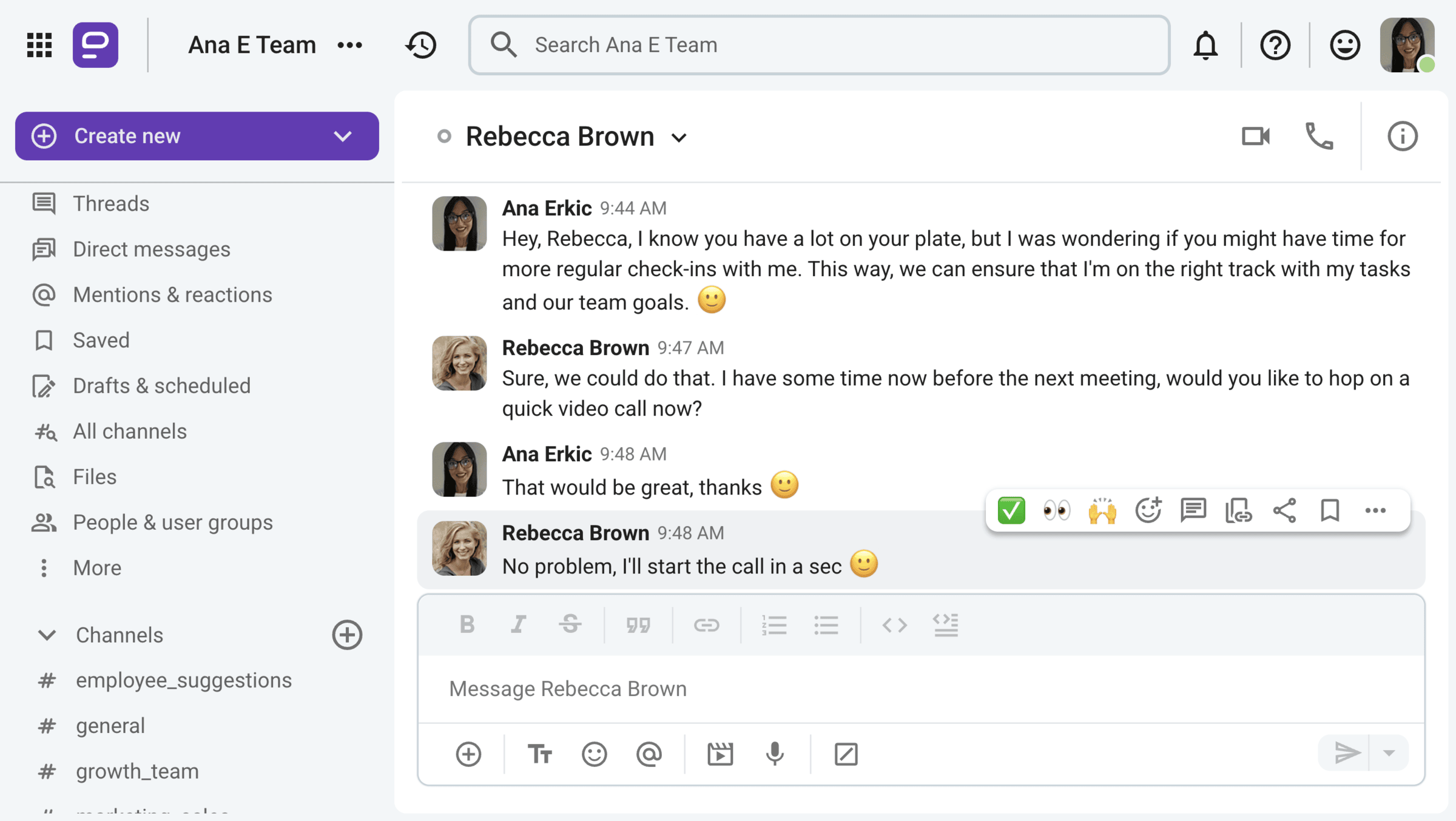
Why is upward communication still so rare? Common barriers
Lately, companies have realized just how important the bottom-up information flow is for healthy team communication. That’s why they started actively encouraging upward communication in the workplace.
Yet, a recent study Leaders’ tendency to over- and underestimate themselves and their organizations indicates senior managers see fewer problems than their junior colleagues — as a result of insufficient upward feedback.
Interacting with higher-ups can get tricky, especially when employees need to provide critical feedback or in the times of crisis.
Here are some most common barriers that prevent a healthy flow of information up the command chain:
- Deeply-rooted fear — We have an ingrained, deeply-rooted, evolutionary fear of confronting authority figures, which activates when speaking to our bosses.
- Autocratic leadership behavior — When leaders are highly dictatorial, dismiss any input, and even punish any attempts to speak up, they suffocate all efforts at sharing.
- Ingratiation — When all the manager hears are sweet lies, they get a wrong picture of their performance and relationship with the team.
The high cost of silence: The tangible effects of poor upward communication
Upward communication is not only beneficial for lower-level employees — when information is allowed to flow freely across all hierarchical levels, everybody wins!
Unfortunately, not all organizations welcome all voices to the forefront.
To illustrate the importance of upward communication, let’s examine what happens when it’s poor or non-existent.
Leaders have incomplete perspective about growth opportunities
Through upward communication, and especially feedback, managers can discover ways to grow and become better leaders.
Just like employees, managers might be doing something wrong without even realizing it, and, without the timely feedback, they may miss getting a clearer picture of their leadership and executive communication skills and what they need to work on.
Management is in the dark about the state of their team
If supervisors are not aware of the problems their employees might be experiencing, they can’t fix them or help other team members work on them.
It’s not only about problems, either — if they’re disconnected from their team, they’ll fail to recognize individual accomplishments and strengths, which can negatively affect employee morale and productivity.
Keep everyone in the loop with Pumble
Leadership is limited to poor decision making
By not including their team in the decision-making process, managers are missing the benefits of bringing different skills, perspectives, and opinions into play. This kind of diversity is proven to lead to better decision making.
If a team collaborates on a project the manager needs to make a decision about, first-hand insight is crucial for making the right choice.
At the same time, if the upward communication doors are not open, managers are at risk of not making the right decisions.
Stress in the workplace is rampant
Ineffective corporate communication makes employees stressed out, according to a 2024 Grammarly study.
Moreover, the study we already mentioned, Belonging in the Workplace, shows that 25% of employees who feel they can’t openly express their opinion at work link this directly to worsened mental health — such as anxiety or depression.
Open and honest communication with their supervisors can help solve this problem and drastically improve employee well-being in the workplace.
Job satisfaction and the sense of inclusivity are low
When people don’t feel heard and appreciated, they are much more likely to not enjoy their job. Consequently, they get worse at doing their job.
The numbers are clear — upward communication positively affects job satisfaction. According to Pumble’s Workplace Communication Statistics, those who feel heard at work are 4.6 times more likely to feel empowered to perform their best.
Moreover, if employees don’t feel like their voices are heard, their sense of purpose and belonging in the company suffers. They are much less likely to share in the company’s values or feel motivated to take initiative in achieving their shared goals.
Success is in question
The obstructed bottom-up flow of communication decreases employee engagement, which leads to decreased productivity, and ultimately — lower profits for the company. The Harvard Business Review suggests managers should actively solicit feedback from their employees and act on it if they want to ensure sustainable success.
Turnover rates are high
As we have seen, employees are much less satisfied at work when their voices aren’t being heard and appreciated. Thus, they are much more likely to quit prematurely.
This way, without the proper upward communication, companies increase their turnover rates.
High turnover can cost a company between $228 million and $355 million a year in lost productivity, not to mention that excessive turnover can damage the company’s reputation as an employer.
Innovation is stifled
No one is more familiar with your company operations than front-line employees. Without their regular input, you’re missing valuable contributions of innovative ideas on how you can improve your operations and take them to the next level.
5 Actionable strategies to build a culture of upward communication
For lower-level employees’ voices to be heard and acknowledged, leaders need to foster a culture of upward communication in the workplace.
Seems easier said than done — but it doesn’t have to be overly complicated if you use the right strategies.
Let’s examine how to encourage upward communication and uplift employees to speak up.
#1 Lead by example and ask for feedback
Just like employees are subject to regular formal performance reviews, so should you as a leader encourage them to give you regular feedback.
As one of our expert contributors, Jessica Plonchak, LCPC, LCSW, and executive clinical director, points out, leaders play a main role in fostering a feedback culture. It all starts with transparency and honesty:

“When leaders admit their mistakes and openly talk about learned lessons, it shows everyone that vulnerability is a core strength. Companies should also praise/reward honesty in addition to performance. Acknowledging employees who speak thoughtfully makes the truth an integral part of a system.”
Apart from encouraging your employees to reach out to you informally about anything that bothers them, you should:
- Conduct surveys,
- Hold one-on-ones, or
- Ask for other forms of formal feedback in regular intervals.
This way, you’re letting your team know that their observations about your performance are just as important as yours about their performance.
This ties well with another key piece of the upward communication puzzle Jessica Plonchak stressed out as critical for leaders who want to encourage their teams to share more openly — emotional intelligence.

“Leaders should be well-trained in emotional intelligence, such as listening without judgment and suggesting feedback accurately to build a healthy relationship with employees.”
Foster healthy team communication with Pumble
#2 Create spaces for upward communication
Before you start building actual spaces and channels for upward communication, it might be best to first work on creating a safe psychological environment for these conversations.
Jessica Plonchak believes that psychological safety is the main building block upon which the culture of upward communication is built and developed.

“When some individuals fear judgment or retaliation, they can’t convey their best ideas, and they tend to hide problems that should have been addressed in the first place.”
Moreover, she reminds us that a culture of healthy upward communication shouldn’t be a one-and-done instance solely reliant on annual feedback, but a continual focused effort.

“A culture of openness and fairness cannot be built by asking for annual feedback; rather, it is built through consistency, regular modeling, and sustained emotional safety.”
It’s a great idea to establish a detailed internal communication plan so that employees understand the best channels through which they can reach out depending on their reason for contacting you.
For example, if they want to discuss the possibility of a promotion, you might instruct them to schedule a one-on-one meeting with you using your communication app.
On the other hand, if your team have a quick question or note, they can either DM you or write in the relevant team channel (e.g., if they have a suggestion for you, they can write in the #manager_feedback or #employee_suggestions channel).
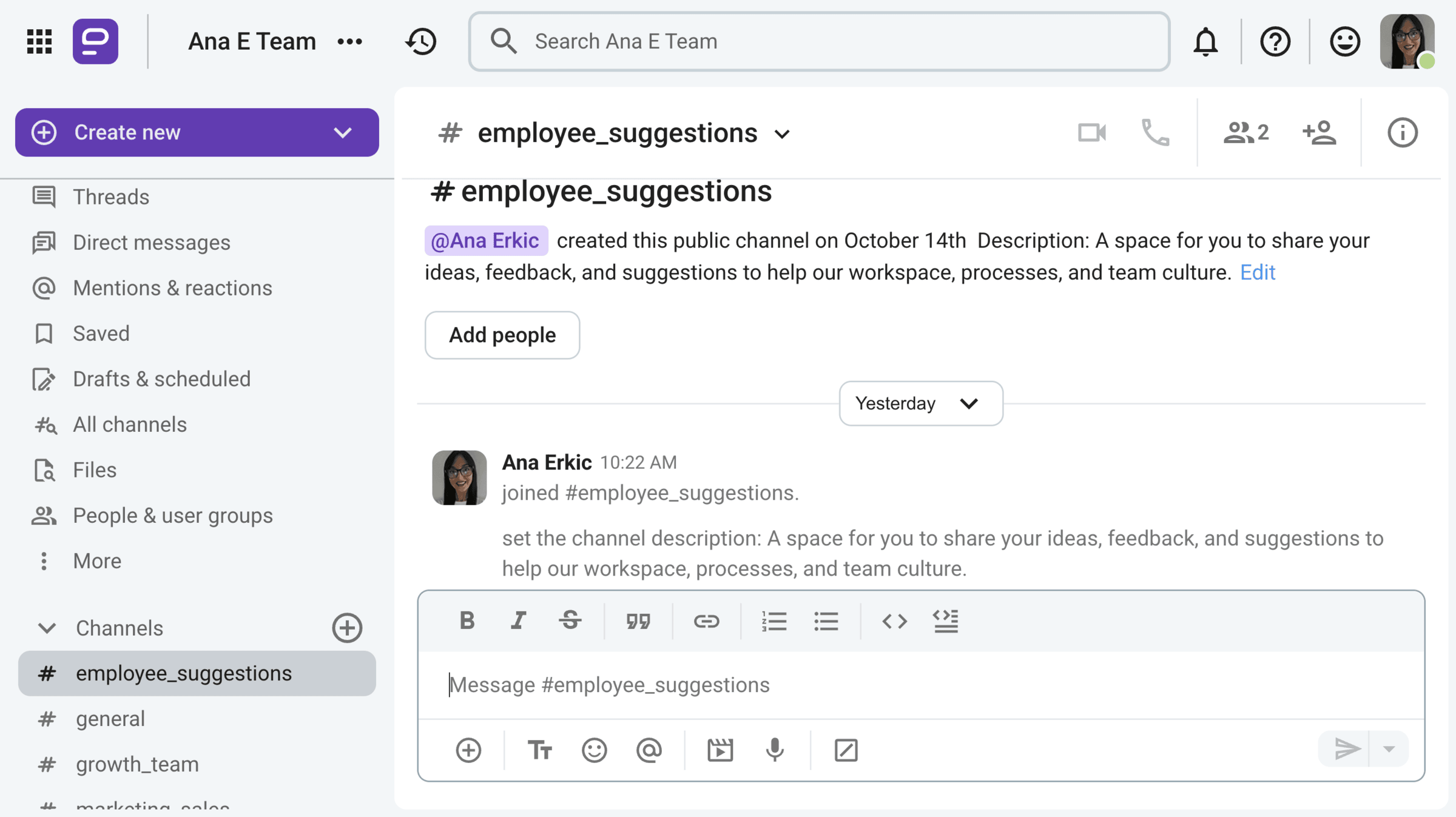
#3 Practice active listening and acknowledge all input
Be open and receptive.
None of these efforts will yield results if you invite employees to share but then reject their ideas, become defensive when they provide critical feedback, or punish them for being honest.
Practicing active listening goes a long way in creating a culture open to upward communication by:
- Showing a positive attitude and regard to people sharing upwardly,
- Focusing all your attention on the speaker offering feedback, and
- Being flexible to adjust your response to the speaker and the specific situation.
We spoke with Burkan Bur, a managing director for a marketing company, and he highlighted the importance of flattening out hierarchy amongst team discussion as one of the key first steps toward more open upward communication. In his words:

“Titles vanish and curiosity rules the day. After all, when junior team members see leadership is sincerely asking, ‘What do you think we overlooked here?’ it is amazing what candor you will receive.”
One of the ways you can achieve this is by actively working on your communication skills so that you can handle any communication situation with ease and grace — and build trust with your team members.
#4 Foster a culture of participation
Invite participation from your team by showing that you value their ideas and opinions.
Here are some examples of how to do that:
- Have brainstorming sessions together.
- Create sheets where everyone can pitch their ideas for various projects.
- Have individual team members share tips with others within their area of expertise.
- Create a dedicated channel in your team collaboration software where everyone can share useful files and other resources they deem valuable for the project.

#5 Act on feedback and close the loop
Finally, once you’ve done all the steps to encourage all voices, the crucial last step is to act on suggestions and requests.
Because, let’s face it, even with the most upward feedback-friendly workforce and receptive managers, inaction renders these efforts useless. Worse still, failing to update those who proposed actions about the next steps will lead them to feel their input falls on deaf ears, discouraging future contributions.
As our contributor, Burkan Bur, concludes, closing the loop and acting on feedback helps employees understand that their opinion matters and makes a difference:

“For instance, if a participant in a brainstorming session offers an idea, I make sure to tell him or her what subsequently happens with it, whether it’s adopted, tabled, or experimented with, and why. When team members see that their voice ties directly to results, they tend to engage and contribute more.”
The right infrastructure for honesty: How your tools can help
Building a culture of open, upward communication doesn’t just happen. It needs the right setup.
If you want people to speak up, you need to give them the right tools to do so.
That means choosing communication tools that don’t just keep the work moving, but actually make it easier for employees to share their thoughts and ideas, ask questions, and offer suggestions without feeling like they’re stepping out of line.
You can instruct your team to start by thinking about the message they want to communicate and then pick the channel that suits it best.
If it’s a formal request, they may want to use email, as it’s still considered the right way to go for more official types of inquiries.
On the other hand, if they have a suggestion after a presentation, they can send a quick message in your team communication app.
And, when employees want to talk about something a bit more personal, like their career goals or future path, you can schedule a live or video conference meeting.
The bottom line is that the more thoughtful you are about where and how you let your team speak up, the more likely it is that it will land well.
Create safe spaces
A culture of feedback needs safe, accessible channels.
Let’s face it — old tools like a physical suggestion box hardly cut it anymore.
If you want employees to freely express their thoughts, you have to make it easy, safe, and natural to do so. That’s where modern communication tools like Pumble come in.
As we mentioned earlier, one of the biggest barriers to upward communication is fear. Whether it’s fear of saying the wrong thing or stepping on toes, your team will most likely feel super uncomfortable openly sharing upward.
And what the right tools help you do is take a lot of that fear away.
For example, setting up private channels in Pumble gives employees a more comfortable space to communicate their ideas, concerns, or suggestions without having to voice their input in front of the entire team.
It’s an equivalent to pulling a few people aside for a quick conversation on site instead of speaking up in a company meeting.
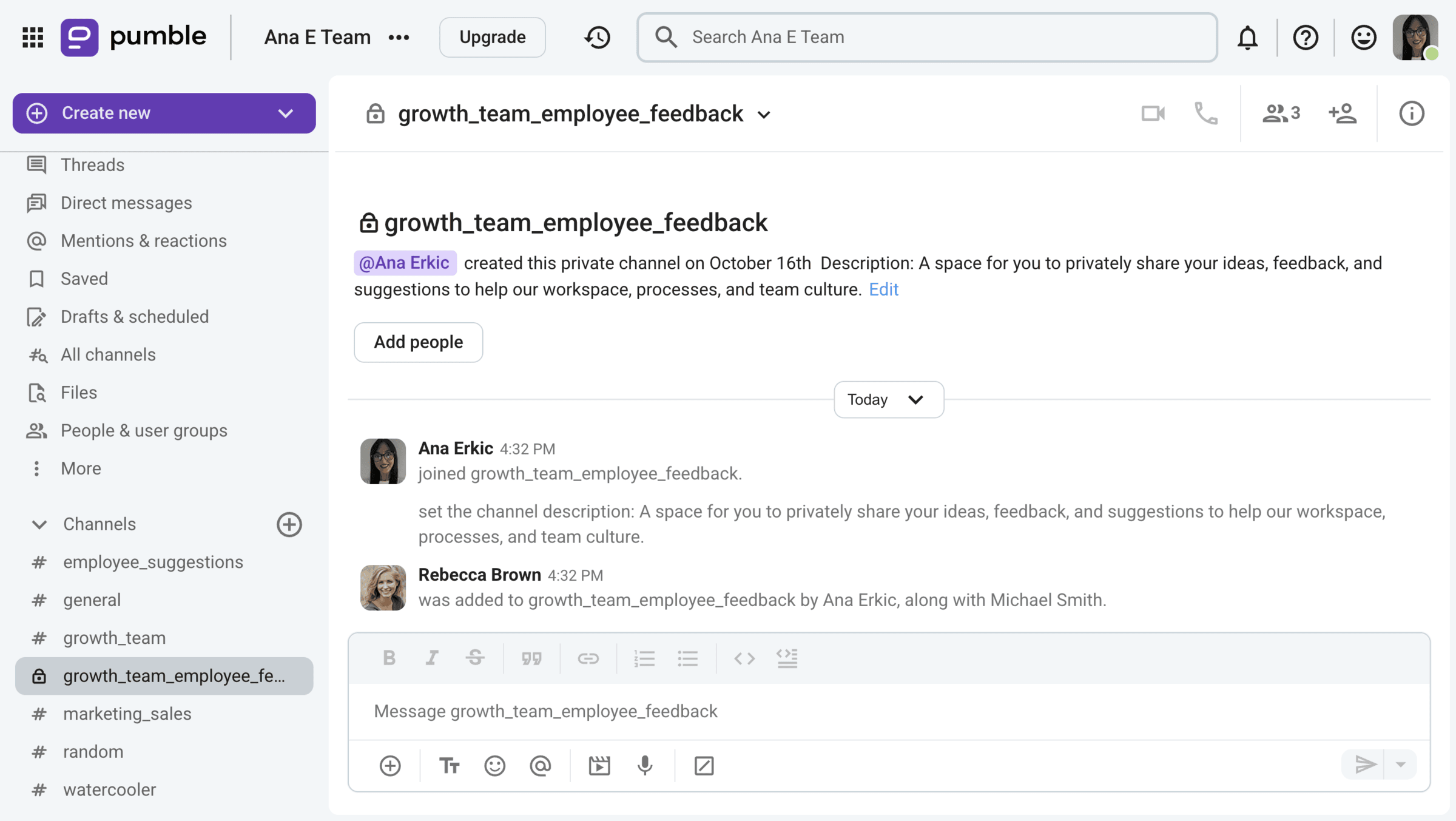
Moreover, a secure messaging app also keeps your conversations confidential and safe from loss, leaks, and misuse, which is critical for gaining your team’s trust to openly share.
Keep your conversations, videos, and files truly confidential in Pumble
Create contextual feedback with threads
You don’t want valuable feedback to get buried in the noise.
That’s where threads in a business messaging app like Pumble really shine.
Let’s say you’re discussing upcoming changes or announcing a new project. Team members can respond right there in a thread, keeping their feedback tied directly to the topic.
Threads thus:
- Keep the conversations organized,
- Make them easy to follow, and
- Ensure suggestions and concerns are recorded.
Instead of derailing the main conversation line, threads keep the feedback neat and focused.
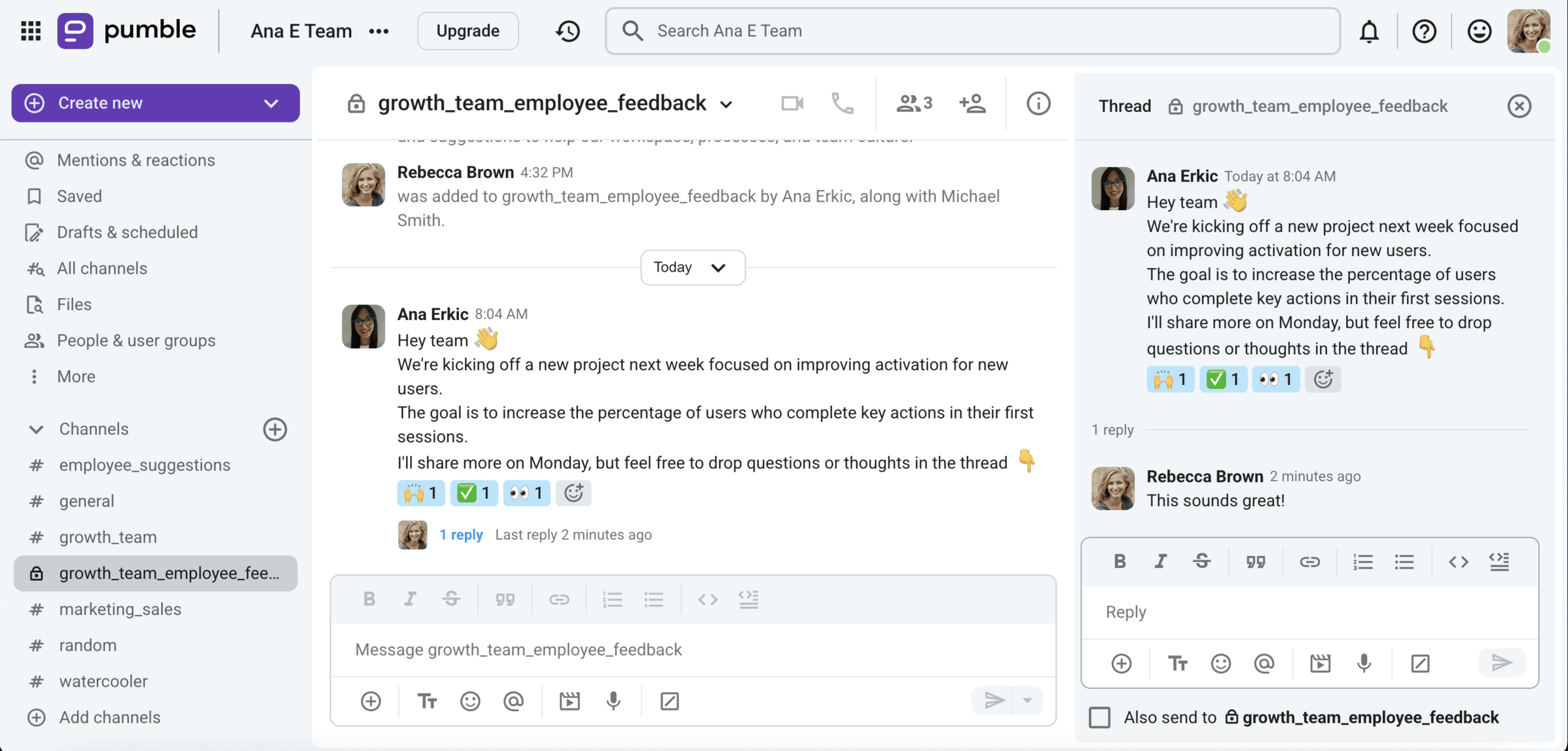
Keep a record of being heard
One of the best ways to show employees that their feedback matters is to actually keep track of it, and respond.
Pumble’s unlimited message history makes that simple. Everything is searchable and permanent, which means nothing can ever get lost.
If someone made a suggestion a few weeks ago, it’s easy to pull it up and show that it was heard, considered, and maybe even acted on.

That kind of transparency builds trust and, when people trust that their voice matters, they’re more likely to speak up more often.
Enhance your upward communication with Pumble
To improve the information flow from subordinates to superiors, it is paramount to use an efficient workplace communication app, such as Pumble.
With Pumble, your team can always reach out to you directly, thanks to direct messages and private and public channels.
Fostering upward communication is easy when you use the right communication channel. So, if you have something confidential to discuss or simply prefer face-to-face communication, you can schedule audio or video calls.
During video calls, participants can share their screens to make their points clearer, presentations more engaging, and ensure they’re communicating as effectively as possible.
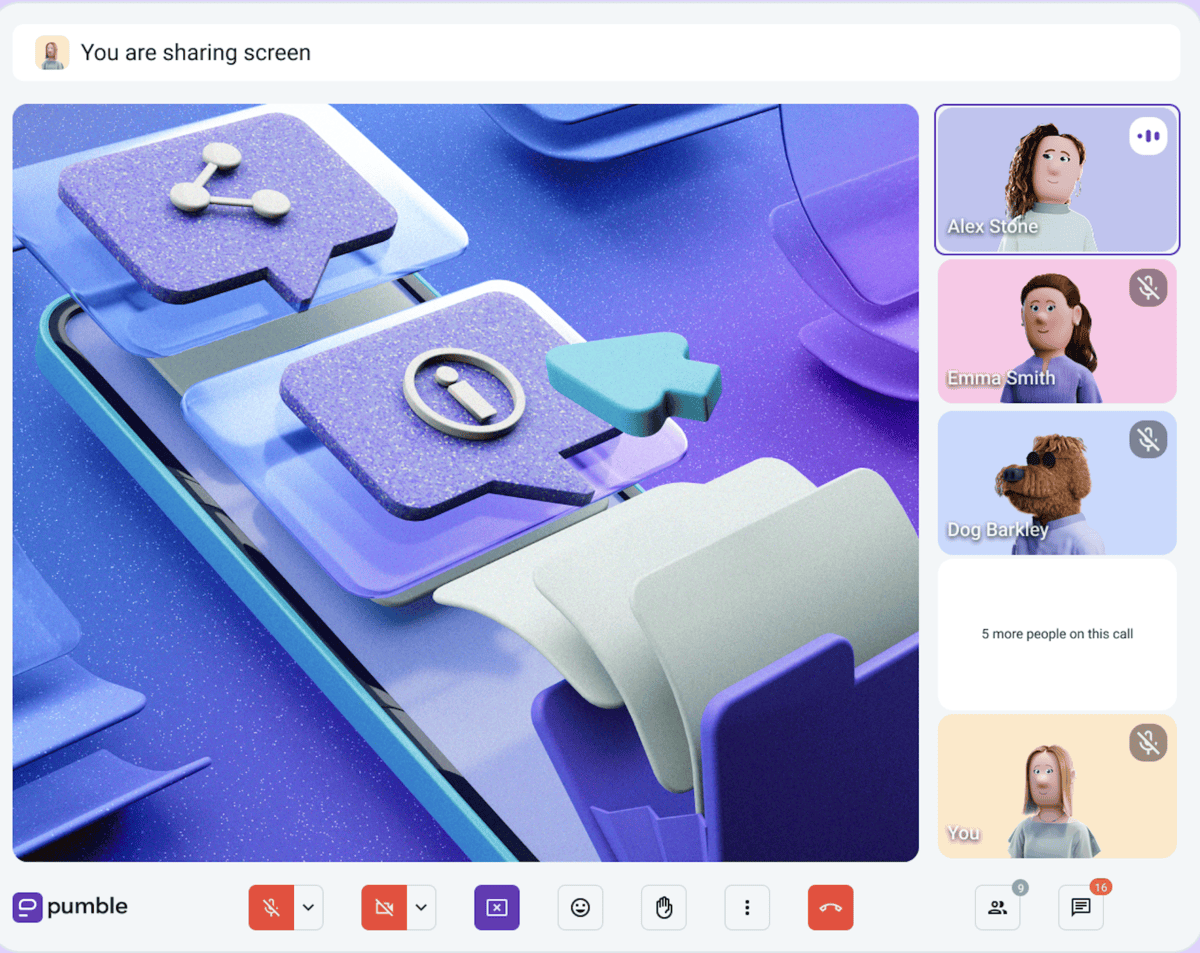
No matter what you say or share in your Pumble workspace, it will be 100% confidential and stay within hand’s reach, thanks to Pumble’s advanced security features and unlimited message history.
Enhance your upward communication and melt the proverbial hierarchical iceberg of ignorance — with Pumble!








